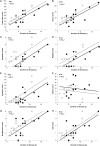Comparison of the Huntington's Disease like 2 and Huntington's Disease Clinical Phenotypes
- PMID: 31061838
- PMCID: PMC6476590
- DOI: 10.1002/mdc3.12742
Comparison of the Huntington's Disease like 2 and Huntington's Disease Clinical Phenotypes
Abstract
Background: Huntington's disease like 2 (HDL2) is the most common Huntington's disease (HD) phenocopy in many countries and described as the phenocopy with the greatest resemblance to HD. The current clinical description of HDL2 is based on retrospective data. It is unknown whether HDL2 has clinical features that distinguish it from HD.
Objective: To describe the HDL2 phenotype and compare it to HD systematically.
Methods: A blinded cross-sectional design was used to compare the HDL2 (n = 15) and HD (n = 13) phenotypes. African ancestry participants underwent assessments, including the Unified Huntington's Disease Rating Scale (UHDRS). The UHDRS motor component was video recorded and evaluated by blinded experts and the inter-rater reliability calculated.
Results: Both groups were homogeneous in terms of demographics and disease characteristics. However, HDL2 patients presented three years earlier with more prominent dysarthria and dystonia. Raters could not distinguish between the two diseases with a high level of agreement. No significant differences in the TMS between HDL2 and HD were found. In both disorders, disease duration correlated with motor scores, with the exception of chorea. Psychiatric and cognitive scores were not significantly different between the groups.
Conclusions: The HDL2 phenotype is similar to HD and is initially characterized by dementia, chorea, and oculomotor abnormalities, progressing to a rigid and bradykinetic state, suggesting the UHDRS is useful to monitor disease progression in HDL2. Although HDL2 patients scored higher on some UHDRS domains, this did not differentiate between the two diseases; it may however be emerging evidence of HDL2 having a more severe clinical phenotype.
Keywords: Huntington's disease; Huntington's disease like 2; Huntington's disease phenocopy; chorea; phenotype.
Figures



References
-
- Margolis RL, O'Hearn E, Rosenblatt A, et al. A disorder similar to Huntington's disease is associated with a novel CAG repeat expansion Ann Neurol 2001;50(3):373–380. - PubMed
-
- Baine FK, Krause A, Greenberg LJ. The frequency of Huntington disease and Huntington disease‐like 2 in the South African population. Neuroepidemiology 2016;46(3):198–202. - PubMed
-
- Margolis RL, Holmes SE, Rosenblatt A, et al. Huntington's disease‐like 2 (HDL2) in North America and Japan. Ann Neurol 2004;56(5):670–674. - PubMed
-
- Mariani LL, Tesson C, Charles P, et al. Expanding the spectrum of genes involved in Huntington disease using a combined clinical and genetic approach. JAMA Neurol 2016;73(9):1–10. - PubMed
Grants and funding
LinkOut - more resources
Full Text Sources

